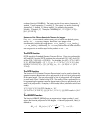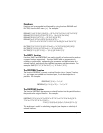
Page 5-20
For example, for n = 2, we will write:
Check this result with your calculator:
LAGRANGE([[ x1,x2],[y1,y2]]) = ‘((y1-y2)*X+(y2*x1-y1*x2))/(x1-x2)’.
Other examples: LAGRANGE([[1, 2, 3][2, 8, 15]]) = ‘(X^2+9*X-6)/2’
LAGRANGE([[0.5,1.5,2.5,3.5,4.5][12.2,13.5,19.2,27.3,32.5]]) =
‘-(.1375*X^4+ -.7666666666667*X^3+ - .74375*X^2 +
1.991666666667*X-12.92265625)’.
The LCM function
The function LCM (Least Common Multiple) obtains the least common multiple
of two polynomials or of lists of polynomials of the same length. Examples:
LCM(‘2*X^2+4*X+2’ ,‘X^2-1’ ) = ‘(2*X^2+4*X+2)*(X-1)’.
LCM(‘X^3-1’,‘X^2+2*X’) = ‘(X^3-1)*( X^2+2*X)’
The LEGENDRE function
A Legendre polynomial of order n is a polynomial function that solves the
differential equation
To obtain the n-th order Legendre polynomial, use LEGENDRE(n), e.g.,
LEGENDRE(3) = ‘(5*X^3-3*X)/2’
LEGENDRE(5) = ‘(63*X ^5-70*X^3+15*X)/8’
Note: Matrices are introduced in Chapter 10.
.
)(
)(
)(
1
,1
,1
1 j
n
j
n
jkk
kj
n
jkk
k
n
y
xx
xx
xp ⋅
−
−
=
∑
∏
∏
=
≠=
≠=
−
21
211221
2
12
1
1
21
2
1
)()(
)(
xx
xyxyxyy
y
xx
xx
y
xx
xx
xp
−
⋅−⋅+⋅−
=⋅
−
−
+⋅
−
−
=
0)1(2)1(
2
2
2
=⋅+⋅+⋅⋅−⋅− ynn
dx
dy
x
dx
yd
x


















